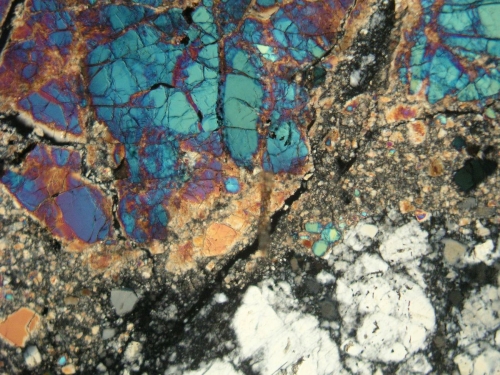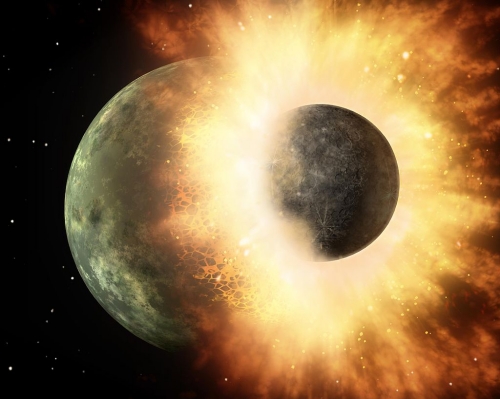Somewhere a decade or so back in these pages a Centauri Dreams commenter described the event that formed our Moon as ‘the big whack.’ Although I hadn’t run across it before, the phrase turns out to have been common parlance for what is now thought to be a massive collision between the Earth and an early planetesimal. But whatever the case, we know a bit more about the cataclysm thanks to new work out of UCLA, as reported in the journal Science.
The impactor, which struck about 4.5 billion years ago, is commonly called Theia. So how do we analyze such a remote event? The key, as discussed in this UCLA news release, is oxygen, which makes up 90 percent of the volume of lunar rocks the team of geochemists studied, and 50 percent of their weight. Usefully, oxygen can manifest itself in various isotopes, the most common on Earth being O-16, meaning each atom holds eight protons and eight neutrons.

Image: Light image of a lunar rock from the Apollo 17 mission. Credit: NASA.
Heavier isotopes like O-17 (with one extra neutron) and O-18 (with two) occur, though on Earth 99.9 percent of the oxygen is O-16. But each of the planetary bodies in our Solar System has a unique ratio of O-17 to O-18, making for a characteristic signature.
To analyze these ratios, the team studied seven moon rocks from Apollo missions 12, 15 and 17, while also working with five volcanic rocks from Hawaii and one from Arizona. Led by UCLA’s Edward Young, the team found no difference between the Earth’s oxygen isotopes and those of the Moon. This contradicts a 2014 study from Germany (also published in Science) that argued for a distinct ratio of oxygen isotopes on the Moon as opposed to the Earth.
Theia was probably a growing object that would have become a planet in its own right. It may have been as large as the Earth, though some believe it was closer in size to Mars. If the UCLA work is correct, the oxygen isotope data tell us that the collision would have been head-on, for if it had been a glancing blow, the great bulk of the Moon would have been made up of Theia, and would thus have shown different oxygen isotope ratios than the Earth’s. A head-on collision should have produced a similar chemical composition on both Earth and Moon.
“Theia was thoroughly mixed into both the Earth and the moon, and evenly dispersed between them,” Young said. “This explains why we don’t see a different signature of Theia in the moon versus the Earth.”

Image: Artist’s depiction of a collision between two planetary bodies. Such an impact between the Earth and a Mars-sized object likely formed the Moon. Credit: NASA/JPL-Caltech.
Thus a head-on collision, as theorized in 2012 by Matija ?uk (SETI Institute) and Sarah Stewart (UC-Davis), and also by Robin Canup (SwRI) in the same year, now has more weight. The catastrophic impact’s possible role in removing any water found in the early Earth is not known, though water from small asteroid and comet impacts would eventually be plentifully available.
The paper is Young et al., “Oxygen isotopic evidence for vigorous mixing during the Moon-forming giant impact,” Science Vol. 351, Issue 6272 (2016), pp. 493-496 (abstract). For the German work in 2014, see D. Herwartz, A. Pack, B. Friedrichs, A. Bischoff, Science 344, 1146–1150 (2014).



I’m afraid Bob Shaw wasn’t describing anything a decade ago, because he died almost exactly twenty years ago.
I would have sworn it was Bob Shaw, but obviously not! When I get a minute, I’ll poke around and see who said it. Thanks.
Good Work,
Head on collision?
Do they mean the Theia was orbiting counter to the Earth when it struck Or
Do they mean Theia overtook the Earth directly from Behind?
If it’s the latter they need to stop using the term Head-on-Collision, it means
something else.
And if it’s the former, I can’t believe two massive objects like that
would not shatter when coming head to head.
Clearly they are not describing orbital dynamics but the angle of the actual collision, as described from either body.
“In these pages”? Bob Shaw (a good friend, and we did ‘Galactic Tours’ together in 1991) died in 1996 — 20 years ago!
Yes, you’re not the first to notice. I’ve fixed the original post but will dig around to see what it was that convinced me it was Bob Shaw. Maybe a similarity in name or something. Sorry.
It was Dr William K. Hartmann who actually proposed this hypothesis, I think in 1974. But it was never ‘head-on’, but a glancing blow by a Mars-size object, which presumably followed the same type of elliptical orbit and direction as other solar system objects but got deflected.
Oxygen isotope ratios will depend on the rocks you are analyzing. Biologically generated sedimentary (and by implication, metamorphic) rocks will have a slightly different ratio due to preferential biological uptake. There are other geologic effects that impact isotope ratios that will have occurred on Earth but not on the Moon.
I don’t have access to the Science paper, but I trust the analysis was done on unweathered, igneous rock of the same type as found on the moon to be directly comparable. (The abstract does not go into any detail. Nor in the 2001 Wiechert paper abstract).
Here is a nice accessible paper on analyzes of ancient terrestrial zircons and the effect of water on oxygen isotopic ratios:
Oxygen isotope ratios and rare earth elements in 3.3 to 4.4 Ga zircons: Ion microprobe
evidence for high 18O continental crust and oceans in the Early Archean
Ideally we need to nail this down using different elemental and isotopic ratios that orthogonally fix the composition of the two bodies as the same.
I have issues with a direct impact as they would normally vaporise both bodies if fast enough or not enough material would have been thrown clear to successfully orbit the Earth. I am thinking Thea ‘fell’ from a LaGrange point and due to a similar orbit could have had similar isotopes to begin with and then had an off centre impact to throw material into orbit.
Why should there be any difference in Oxygen isotope ratios or any other isotopic ratios in Solar system objects? The proto-planetary disc material should have provided a common source of building material for all Solar system objects would it not?
Did the different physical properties of the various planets cause change to their isotopic ratios over time through the different kinds of weathering and other chemical processes?
Yes,exactly my question too !
“But each of the planetary bodies in our Solar System has a unique ratio of O-17 to O-18, making for a characteristic signature”
My question as well. I imagine there are some learned folks here who can explain.
The difference in temperature across the solar system is quite a lot, now with different amounts of radiation coming from the sun atoms can be separated according to their masses, absorption spectrums, crystal differentiation favouritism and life can too favour one isotope over another.
My understanding is isotopes are mass-differentiated in the proto-planetary disk along the radius axis due to physical mechanisms stemming from temperature and solar flux gradients.
The precise details are fuzzy to me but the bottom line is at different distances from the Sun, bodies will be formed out of different and distinctive distributions of isotopes.
If I recall correctly, the German paper claimed to detect a subtle but definite small difference in isotopic makeup of the Moon and Earth. Furthermore the paper claimed that the isotopic differences were sufficiently small enough to imply that Theia and Tellus* formed at similar orbits and may had switched positions as they orbited the Sun like the Saturn moons: Janus & Epimetheus.
There is definitely some tension between conclusions from the recent and German papers, but I don’t think they do contradict each other. I need to dig out the German one and reread.
* Tellus, the technical name given to presumed bigger of the two proto-bodies that collided and merged to form the Earth-Moon system.
Presumably the isotope ratios on different bodies vary a little, randomly, to make each recognizably different. We need not speculate on this, no doubt it has been established very well. “Head-on” here means in the center of mass reference frame. It does not imply opposing orbits, just orbits that intersect to within a distance much smaller than the size of the objects. The alternative, a glancing collision, is when the orbits intersect to within a distance not much smaller than the size of the objects.
The Theia impact could not have been exactly head-on, because then there would not have been any angular momentum left over for the Moon’s orbit. It seems to me that the “impact parameter” (i.e. the ratio between orbital distance and combined radius) determines the angular momentum of the Earth/Moon system, and can therefore be calculated fairly precisely from it.
Anyone know why that would not be much better than circumstantial evidence based on mixing and isotope ratios?
Well, angular momentum is the product of the impact velocity and the impact parameter. A given angular momentum could either have been produced by a slow glancing impact, or a fast near-head-on collision. Since we do not know the velocity, the impact parameter is also unknown, and we have to resort to circumstantial evidence. Or so I think…
If the proto-planets had co-rotation i.e. rotated the same way, a torque would have been present which may have even allowed a centre-centre impact to throw material into orbit. But as you state we do not know the original momentum vectors and so we need to guesstimate a bit
Both initial and final states (pre- and post-collision) have three kinds of angular momentum: one rotational for each of the two bodies, and an orbital angular momentum of their relative motion to each other. In order to calculate any impact parameter, you’d need to know the initial rotational angular momenta for each of the two colliding bodies.
In fact, the degree of mixing vs. the amount of glancing aren’t really in contradiction to each other. If you model an intermediate of the two combined masses as a (highly-viscous) spinning liquid drop, you can get significant internal mixing for a period followed by spontaneous separation into two bodies. A high rotational angular momentum of an intermediate need not be stable. Just like a flywheel spinning past the tensile limit of its rim, such a body can spontaneously split.
I thought the same thing, couple of things come to mind: first if some of the material escapes altogether, it can take some of the angular momentum with it, second, how does the collision and aftermath exchange angular between earth-moon and orbital angular momentum around sun?
Also, angular momentum in earths rotation is non-negligible [1], and I have no idea if earth’s spin before collision can be estimated..
[1] http://www.ast.cam.ac.uk/~wyatt/poa_201415_originofmoon.pdf
@ Mike: As I understand it the disk wasn’t evenly mixed, and different parts had diffeent isotope ratios.
There is (or was) a commenter here named Bob Shaw, but he’s not the SF writer.
Figure 1: Oxygen isotopic similarities and differences.
From:
Solar System: An incredible likeness of being
Robin M. Canup
Nature 520, 169–170 (09 April 2015) doi:10.1038/520169a